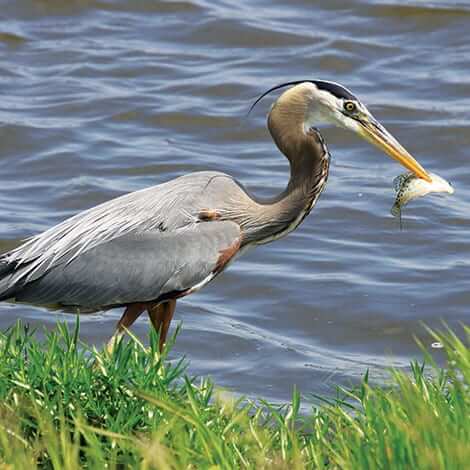The great blue heron is well known to many pond owners that stock their pond with fish. While they are easy to spot with their blue-gray plumage, black stripe over their eyes and a thick dagger like beak, they are not easy to keep away from your pond.
Breeding Season
These protected birds can be seen throughout the year here in North America mostly soaring through the air with their 6-foot wingspan and 4-foot long body. Great blue herons can be seen together during the mating season that ranges from the beginning of September and October with a return in Mid-March through June, however when it is time to find food they fly solo.
Hunting Techniques
A common hunting technique is to soar through the air looking for a quick bite to eat, usually in wetlands or ponds and lakes. They prefer to sit motionless along shorelines or in shallow waters and wait patiently for a snack to swim by. Another technique is to walk slowly flushing out any potential prey that may be hiding with their feet.
The great blue heron is an intelligent bird so you will need to get creative when it comes to encouraging them to hunt in a different location. Here are some tricks to try:
- Decoy: The first line of defense should be when a heron has yet to discover your pond and should only be used after mating season. The theory is that herons often hunt alone and do not want to fight for their fishing spot so if they see a heron decoy near the pond, they will seek an alternative body of water. Remember herons are very intelligent and will catch on quickly if a decoy stays in one spot for too long so keep it moving to keep it guessing.
- Add Movement: Adding an aerator or a beautiful fountain display can do more than adding oxygen to the water and setting a pretty scene. The added movement in the water can challenge the heron's sight when flying above.
- Create an Illusion: Herons will typically fly over looking for shallow water to wade in and look for fish. Adding a little bit of pond dye can create an illusion that the pond is deeper and will make it harder for fish to be seen from a long distance.
- Provide Hiding Places: Just in case a heron chooses your pond for its hunting grounds, give your fish a place to hide. Fish habitat like the Honey Hole Shrub or Fish Attractor Spheres can provide an added layer of protection.
- Create Obstacles: Herons have the tendency to land around the perimeter of the pond and walk up to the water. Obstacles, like the Heron Stop make access difficult by creating an impassable barrier up to 40' of shoreline, without obstructing the view of your pond.
- Scare Tactics: Startle herons and other predators to scare them away with a spray of water using a motion-activated sprinkler can protect an area up to 1200 square feet, connected to a garden hose and powered by a solar panel; motion sensors trigger the stream of water.
- Cold Weather Relief: Herons are migratory birds, and they have no appreciation for cold weather. So if you're located in the cooler northern climes - particularly where ponds tend to freeze during the winter months - you'll usually notice their absence when temperatures start to drop. Like many of us would like to do during winter, herons that choose to migrate will head for Central America and northern South America to warm up and fill up on fish. If you live in warmer portions of the United States, however, you may see herons all year 'round, provided there's enough open water and food to keep them happy.
As you can see there are many tactics you can use to your advantage in protecting your fish from herons. We recommend using a variety of methods to discourage them from landing on your property because eventually, they will figure out they won't be harmed.
Last Updated: February 1, 2023
